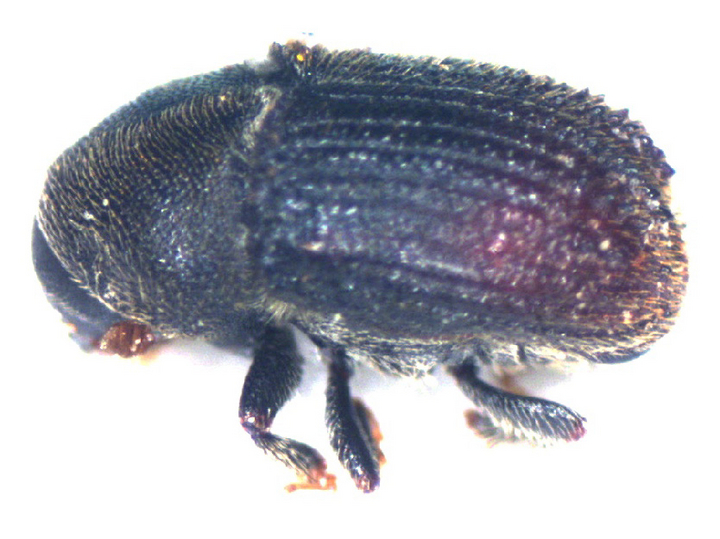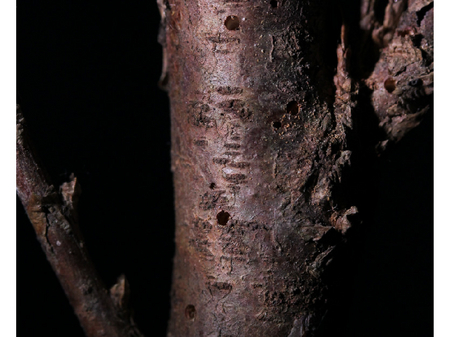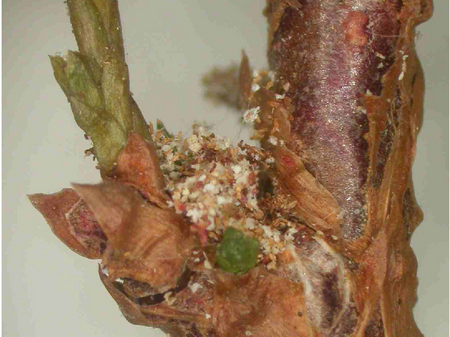Cedar bark beetle
Phloeosinus aubei, P. thujae and P. rudis
Profile
Thuja bark beetles can cause damage to cypress-like conifers and are responsible for a good proportion of damage, especially to thuja. Besides the native juniper bark beetle(P. thujae (Perris 1855)), mainly the bicolored thuja bark beetle(P. aubei (Perris 1855)), originating from Southern Europe, has become damaging in our country for several decades. The Japanese thuweed bark beetle(P. rudis (Blandford 1894)), originating from East Asia, has also been reported from southern France and the western Netherlands.
Appearance

The maroon to dark brown bark beetles measure only 2.5 mm in length and have a compact, almost cylindrical body. The strongly curved posterior part of the elytra is covered with small denticles, by which the three species can be distinguished.
The larvae are cream-colored and legless and have strongly sclerotized mandibles at the anterior end.
Biology
Starting in mid-May, the young bark beetles hatch from the bark of infested host plants over a long period of time. First, they carry out a maturation feeding on young twigs. After mating, the female beetles create so-called mother tunnels under the bark of their host plant, where they deposit their eggs in small side niches. The larvae that hatch from these produce further feeding tunnels and live on the plant particles ingested in the process. In our regions, only one beetle generation per year reaches development. After overwintering as larvae, pupation takes place the next spring in a small cavity at the end of the larval duct. In early summer, the adult bark beetle hatches from this cavity, completing the cycle.
Damage symptoms
The bicolored thuja bark beetle causes a very conspicuous damage pattern due to the ripening feeding of its young beetles. Short boreholes start from "branch forks", which can be recognized from the outside at first by the bore dust and the emergence of resin. The interior of the side branches is often hollowed out, and the branch itself is yellowish in color. In all bark beetles described here, the females lay so-called mother tunnels longitudinally in thicker branches or on the main trunk under the bark, from which larval tunnels branch off, which also soon run in the direction of the longitudinal axis. At the end of these passages is a cavity that extends into the sapwood, where pupation then takes place. This is called a pupal cradle. The larval ducts, in contrast to the mother duct, are filled with bore dust. The borehole to the outside has a diameter of about 1 mm. The main damage is caused by the larvae of the beetles. Their feeding tunnels in the bast and the outer parts of the wood disrupt the sap flow and can cause severe damage to the plants and their death.



Distribution
Besides the native juniper bark beetle(P. thujae), mainly the bicolored thuja bark beetle(P. aubei), originating from Southern Europe, has become damaging in our country for several decades. The Japanese thuja bark beetle(P. rudis), which originates from East Asia, has also been reported from southern France and the western Netherlands.
Prevention and control
- Locate infestation sites (heavily infested plants) of the thuja bark beetle: to do this, look for plants with ripening feeding or with bored holes on the main stem. For a more detailed analysis, cut the bark there flat with a knife. In case of heavy infestation, numerous bores will be visible.
- Immediate burning/disposal of heavily infested plants.
- The larvae feeding under the bark cannot be controlled chemically.
- Infested plants are a source of danger for neighboring healthy plants. Branches with incipient ripening feeding should also be cut off and destroyed during the season. Often there are still young beetles inside.
- To control the thuja bark beetles hatching from the main stem, infested and endangered plants can be treated several times between June and September with a plant protection product suitable for this purpose (see list of plant protection products approved in Austria).
Last updated: 11.09.2023
automatically translated